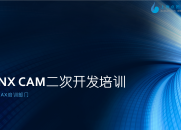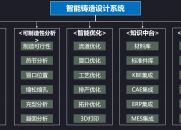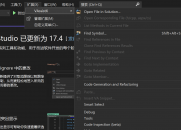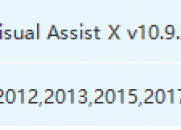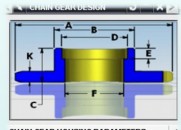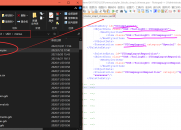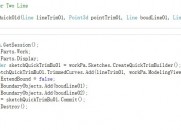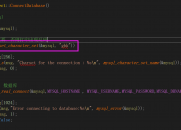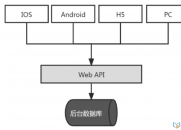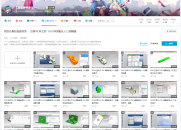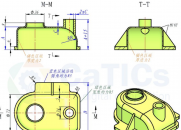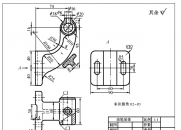|
|
请使用QQ关联注册PLM之家,学习更多关于内容,更多精彩原创视频供你学习!
您需要 登录 才可以下载或查看,没有账号?注册

x
7 k& I8 @- g5 M7 ~, P171. 更改运行调度程序的操作系统用户后,populatefsc 中止在 TRANSLATIN状态 / `2 |2 U' {' }' |! b! t7 x
1 Z% `' v: E# Q0 x [. _
问题 * A' i9 g& ^& F% U
默认情况下,该模块使用 2 层的自动登录,如果操作系统用户不是 Teamcenter 用户,该1 ]7 n3 v- q# |: v( O
模块中的功能无法登录 . I' w0 Y# C& t4 l
/ I/ ]' k7 H" G: ?3 H2 PERROR - 2018/11/29-10:51:46.962 UTC - NoId - 515143: The login attempt failed: either the
2 `" I' Q( P( [9 W3 |: }- W4 Euser ID or the password is invalid.
4 y3 T r( T& j, H* H% e2 t, _' p2 X3 a- y
方法 , Q6 T! s+ G+ Z4 b6 B3 \
修改 populatefsc 脚本,增加登录信息
1 z6 e, b# \1 \) @7 U在 populatefsc.bat 文件中,在 TC_ROOT 和 TC_DATA 的设定后增加如下行 ' B5 z7 f' }- x) ~0 j) v
set TC_DBA_USER=infodba
8 m3 D& s7 h _9 e( }! J( N( f1 C3 m
在 populatefsc.pl 中 :
7 A K' [% N8 L: w/ Q+ d. r( C# e2 P: J4 T
在 runPLMXMLExport 子程序下增加红色标记的代码 5 D" k8 m& u; R; d8 M: B
+ x, `5 g4 \; w6 A& ^
# This will be the full path to the executable.
5 A0 _% [5 h( p) y2 b" _my $exe_path= "$ENV{'TC_BIN'}${dir_separator}${exe_name}${exe_suffix}";
7 f4 u+ u$ n& W& a* Lmy $tcdbauser= "$ENV{'TC_DBA_USER'}"; 1 F/ i% x% Z3 e- k, E
my $pwdfile= "$ENV{'TC_ROOT'}${dir_separator}security${dir_separator}server_infodba.pwf"; 3 C9 H% C7 k# X2 o) S3 V; Y8 B
# Make sure we can find what we are executing. . q) e: r2 w" g- q
die "The ${exe_name} executable was not found at the following location: / \/ k/ _+ f% ^% V, H
${exe_path}\n" unless -x ${exe_path}; 2 C+ Z& y1 W8 n2 }" j9 c
- d* h% z9 p; |! v
# Start building the command line.
2 S3 V' {' t8 W1 @4 x* U1 Jmy @args= ( $exe_path, '-transfermode=ConfiguredDataExportDefault' ); 9 T' U3 B3 a+ N, p& a! u: {( c
2 Y* p* W$ c7 p& |1 L# Take care of possible empty spaces in the argument values 9 Z2 c* k* M. l2 M3 }( E D
my $outputFileStr = $hashRef->{'output_file'};
+ g: Q8 D% R% d1 e: O* J" _" G) Z$outputFileStr = handleEmptySpaceInPath($outputFileStr); 0 O% W7 u9 Y. ?" x7 r \. D
my $scoUid = $hashRef->{'uid'}; . y2 x) d0 o5 A9 Y6 ^ _9 L
$scoUid = handleEmptySpaceInPath($scoUid); ( J2 t" u+ j* \ D. t$ l [, {
) o+ J, \. |& }" e5 O' T
# Add the extra options. 2 f( I, Z) v* M3 d
addOption(\@args, '-xml_file=', $outputFileStr, 1);
+ e: w5 ?9 b: w# O4 z5 ]" v' \addOption(\@args, '-uid=', $scoUid, 1);
' A$ h- w5 I% x3 ?, VaddOption(\@args, '-u=', $tcdbauser, 1);
& V- N3 o& `, N+ h; O5 PaddOption(\@args, '-pf=', $pwdfile, 1); 7 E1 ^: m4 K# h) ^
) u ^! ]7 h, s! ?1 y! L
在 runLoadFscCache 子程序下增加红色标记的代码
8 H6 _/ }' I2 H1 b x! _
/ C! Z g7 s& j2 o* v# This will be the full path to the executable.
0 ?3 U. E' ^8 D8 S4 e* |! c8 Omy $exe_path= "$ENV{'TC_BIN'}${dir_separator}${exe_name}${exe_suffix}"; 6 @$ S8 `! g, u
7 `# J% K; S6 |! v0 n" Y
my $tcdbauser= "$ENV{'TC_DBA_USER'}"; 1 F7 W. I4 w6 Z5 L) {: F
my $pwdfile= "$ENV{'TC_ROOT'}${dir_separator}security${dir_separator}server_infodba.pwf"; 4 O( |8 g v- {. R/ N7 ?' p
# Make sure we can find what we are executing.
( t" K: r' _1 sdie "The ${exe_name} executable was not found at the following location: 7 V! R# T- ]/ N
${exe_path}\n" unless -x ${exe_path};
; e7 X6 ?8 q$ i" S( w* d! y4 w+ Y7 i8 I; w
# Figure out output information from command line input * J1 ]* J' d h- t; b1 ^3 \- \! k
my $outputFileStr = $hashRef->{'output_file'}; - p) R" ?3 a" j( z# s" G% M& J
my $fscUri = $hashRef->{'targets'};
8 g& p3 o9 U% m$ T6 n9 |: m& g
5 ?; z4 N4 o4 m e) S+ b- x# Check possible empty space in the string
' C2 \( E$ ]2 }7 Z- G& D$outputFileStr= handleEmptySpaceInPath($outputFileStr);
W2 K' ~4 Y* D3 J. I$fscUri = handleEmptySpaceInPath($fscUri);
) H+ L& x: }, t6 e$ X. }, ~. S4 T9 i8 ]6 k
# Add the extra options. ) W, n- P k% a `: z+ c
my @args= ( $exe_path, '-f=load' );
8 Q( G( s' c5 t2 r. ~8 o# \addOption(\@args, '-plmxml=', $outputFileStr, 1);
* c @, Z3 ]7 M- oaddOption(\@args, '-fsctargets=', $fscUri, 1); ! O; x2 t: X0 r, r2 m
addOption(\@args, '-u=', $tcdbauser, 1); 7 ^$ D2 Q- j. W# P
addOption(\@args, '-pf=', $pwdfile, 1);
& v/ D3 Z2 S9 ^7 O' h7 @4 C7 k2 c d' m. ?6 ~
; Q* o' B( V, T! ^5 g$ `/ }7 m; A. u; b+ }6 r% P D# j
|
|

